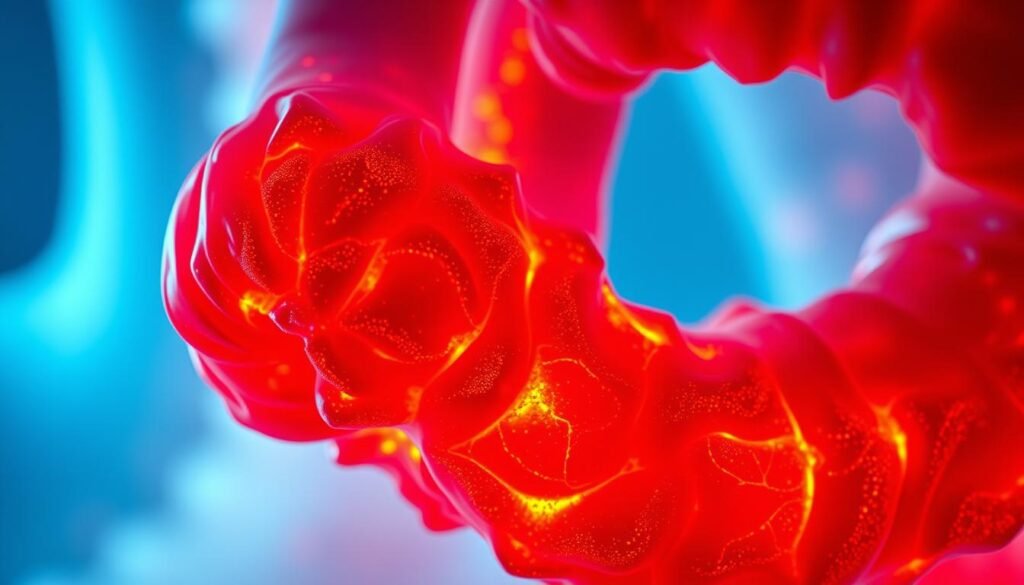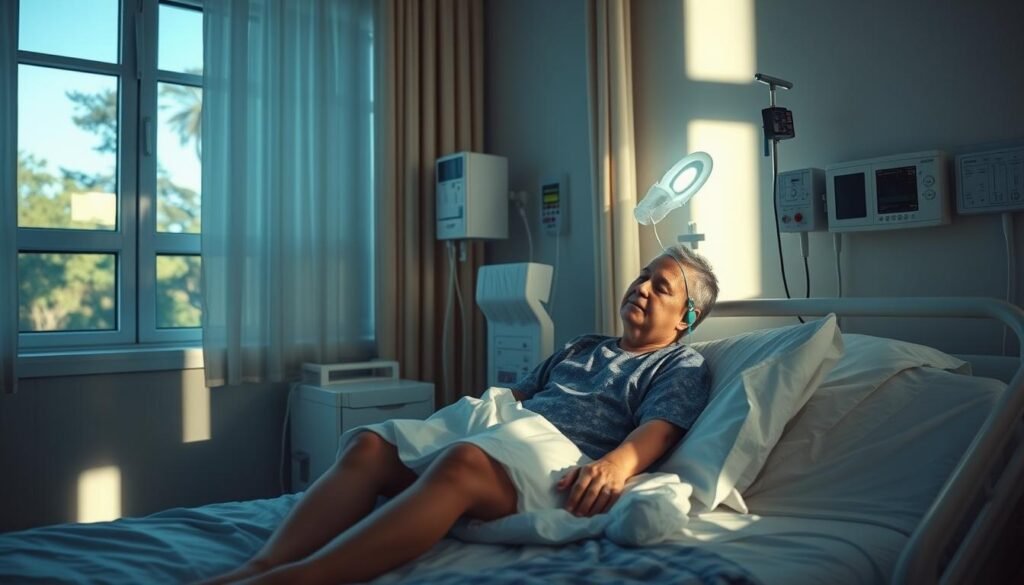About 70% of lung cancer patients go through radiation therapy during their treatment. This fact shows how crucial it is to know the potential side effects. For some, surgery isn’t an option, or the disease is advanced. Radiation helps ease painful symptoms like pain or trouble breathing. But, knowing the side effects is key.
Patients heading into lung cancer treatment should be aware of possible side effects. These can be as mild as skin reactions or as serious as trouble swallowing and ongoing cough. Being informed helps patients and their families get ready both emotionally and physically. This preparation makes the treatment process more supportive.
Key Takeaways
- Radiation therapy is used in about 70% of lung cancer cases.
- Common side effects include fatigue, skin reactions, and nausea.
- Difficulty swallowing can occur and may require dietary adjustments.
- Monitoring side effects is crucial for effective management.
- Most side effects are temporary and improve after treatment ends.
Understanding Radiation Therapy for Lung Cancer
Radiation therapy is key for treating lung cancer, especially non-small cell lung cancer (NSCLC). It uses high-energy rays to kill cancer cells. For some who can’t have surgery, it’s the main treatment. It also helps when used with surgery or chemotherapy, known as chemoradiation.
External beam radiation therapy (EBRT) is most common. Patients get EBRT over weeks. It targets the tumor but saves healthy cells around it. Other types of radiation therapy are:
- 3-D Conformal Radiation Therapy (3-D CRT): This shapes the radiation beams to fit the tumor.
- Intensity-Modulated Radiation Therapy (IMRT): IMRT changes radiation doses for different areas to protect normal tissues.
- Stereotactic Body Radiotherapy (SBRT): Given over 7 to 10 days, SBRT precisely targets the tumor with high radiation doses.
- Brachytherapy: This puts a radioactive source right at or near the tumor.
- Proton Therapy: Uses charged particles to aim at the tumor with less harm to healthy organs.
Radiation therapy lowers the chance of cancer returning after surgery. It helps treat brain metastases or pain from advanced lung cancer. Side effects like fatigue, breathing troubles, and skin problems can happen. It’s important to talk with doctors to manage any side effects.
Common Side Effects of Lung Cancer Radiation
When getting radiation therapy for lung cancer, patients often face common side effects. The treatment can control tumors effectively, with a high success rate. But, it’s vital to be ready for challenges along the way. One major effect is fatigue. This can make daily activities hard and lower life quality.
Nausea also happens often during this therapy. It can make patients feel sick, and sometimes they throw up. It’s key to watch these symptoms and talk about them with doctors. Managing them well can really help with comfort.
Skin changes are typical where the radiation is aimed. This includes irritation, redness, and skin peeling. Knowing how to care for your skin helps lessen discomfort. Loss of appetite is also usual and can lead to weight loss. Being aware of these effects helps in seeking support early. Many of these issues get better after treatment. This shows why talking with healthcare teams is crucial during therapy.
Fatigue and Its Management
Fatigue is a big problem for people getting radiation therapy for lung cancer. Many lung cancer patients, between 57% and 100%, feel very tired. It’s important to know the signs of fatigue because it can really affect your everyday life and healing.
Recognizing Fatigue Symptoms
Fatigue shows up in different ways. Some common signs are:
- Lack of energy
- Sleep disturbances
- Emotional changes, such as increased anxiety or depression
These signs can start showing up early in treatment. They get worse around the third week and are much worse by the sixth week. Low iron levels can make the tiredness feel even worse. That’s why keeping track of your health is key.
Strategies to Combat Fatigue
There are several ways to deal with fatigue. Here are a few strategies that help:
- Pacing daily activities to avoid exhaustion
- Incorporating light exercise, which can enhance energy levels
- Prioritizing rest and relaxation to recharge the body
Getting help from healthcare teams is super helpful. Teams with doctors, psychologists, and nutritionists work together to help you get better. Treating fatigue in many ways is crucial to making life better during treatment.
Skin Problems During Treatment
Patients getting radiation therapy for lung cancer may deal with skin problems. These problems vary by treatment area and personal sensitivity. Knowing the possible skin reactions helps in managing them well. It’s important to spot skin issues early and take good care of your skin. This care is key for comfort and skin health during treatment.
Types of Skin Reactions
Common skin reactions during radiation include:
- Redness and irritation: This looks like a sunburn and can show skin cell damage.
- Dry skin: This can happen from radiation and other cancer treatments, leading to peeling.
- Itching (pruritus): It can be uncomfortable and disturb sleep or cause more skin problems.
- Blisters or peeling: Sometimes, severe reactions cause painful skin damage.
- Swelling: This shows inflammation in the treated area.
- Color changes: Skin color can change because of treatment.
Skin Care Tips
Good skin care during cancer treatment can ease discomfort and help healing. Here are some tips:
- Use gentle soap: Choose mild, unscented cleansers to avoid more irritation.
- Moisturize regularly: Non-irritating moisturizers keep the skin moist, lowering dryness risk.
- Avoid sun exposure: Stay out of the sun as treatments can make skin burn easily.
- Wear loose clothing: Soft fabrics reduce friction and irritation on sensitive areas.
- Stay hydrated: Drinking water helps maintain skin health.
Spotting skin reactions early and ongoing skin care can greatly help cancer patients’ lives. For more on handling skin problems during lung cancer treatment, check the article here.
Managing Radiation Pneumonitis
Radiation pneumonitis may develop after lung cancer treatments. It usually starts 1 to 3 months after radiation. Yet, it can appear up to a year later. Signs like shortness of breath, coughing, and chest pain are common. Spotting these signs early is key to handle it well.
Symptoms of Radiation Pneumonitis
Those with radiation pneumonitis often face breathing issues. Symptoms include:
- Shortness of breath
- Dry or productive cough
- Chest pain or tightness
- Fever
These signs can be confused with other lung problems. Chest CT scans and X-rays help doctors make the right call. Talking to your doctor about any breath problems after treatment is smart. It helps catch issues early.
Treatment Options
Treatments aim to ease symptoms and reduce swelling. Depending on how bad the condition is, treatments may vary:
- Corticosteroids: These are used to lessen inflammation and help with breathing.
- Bronchodilators: They tackle breathing troubles by widening air paths.
- Cough suppressants and decongestants: They’re used to reduce coughing and congestion.
- Oxygen therapy: This is for those with a lot of breathing problems.
In mild situations, symptoms may go away on their own. Yet, severe cases need stronger action. Always tell your healthcare team about any breathing difficulties. For more info on dealing with radiation pneumonitis, check out this resource.
Understanding Radiation Esophagitis
Radiation esophagitis happens when the esophagus gets inflamed due to radiation in cancer treatment. This issue can cause a lot of esophagus symptoms, like painful swallowing. It also increases the risk of food getting stuck in the esophagus. For those getting thoracic radiation for lung cancer, nearly one-third might suffer severe esophagitis. This is more so if they also receive chemotherapy.
Certain factors predict treatment-related esophagus trouble. These include the tumor’s location and whether the patient is female or has a low body mass index. Studies show that 44% of patients receiving radiation face significant symptoms soon after starting treatment. Yet, there’s no clear way to measure this issue. Doctors often use the National Cancer Institute’s Common Terminology Criteria for Adverse Events (CTCAE) for a rough guide.
Doctors are working on better radiation methods to lessen the risk and harshness of radiation esophagitis. They use PET and CT scans to see the esophagus’s size and changes. This could help in understanding radiation injuries better.
Diet changes can help ease treatment-related esophagus discomfort. Speaking with dietitians can provide practical eating tips. For more information, you can read detailed research on radiation esophagitis.

Challenges with Swallowing After Treatment
Many people who go through radiation therapy have trouble swallowing afterwards. This happens because of swelling in the esophagus, which causes discomfort and makes it hard to eat. This swelling can last for a week or more, especially with radiation to the head and neck.
Common Experiences
Patients often feel soreness in their throat and struggle with solid foods. This can make eating a challenge. Many cancer patients face dysphagia, impacting their life quality. Knowing what to expect can help patients deal with these symptoms better.
Dietary Adjustments for Easier Swallowing
Making changes to your diet can help with swallowing problems. Here are a few tips:
- Cut foods into small pieces to make swallowing easier.
- Moisten foods with gravy or sauces to help them go down.
- Choose soft foods like gelatin, yogurt, and pudding.
- Avoid tough foods like nuts, dry cereal, and raw fruits to not irritate.
- Stay away from citrus, spicy foods, alcohol, and tobacco as they can add to the soreness.
- Drink six to eight glasses of fluids a day unless you have other health issues.
If you’re having a really tough time, think about seeing a dietitian. They can give advice that fits your specific needs. Throat sprays and lozenges can give temporary relief. If you still find it hard to swallow, nutritional supplements might be an option.
Dealing with Cough and Difficulty Breathing
Coughing and breathlessness are big issues for those with lung cancer getting radiation therapy. These problems can show up during and after treatment, making life harder. People might feel more breathless because of chest infections, weak muscles, or ongoing lung issues.
To help with these symptoms, doctors suggest several strategies. They might offer breathing exercises and inhalers to keep coughs under control. Staying away from things like cigarette smoke is also important. It’s critical to talk to doctors right away about any new breathing problems.

Some breathing techniques really help with breathlessness. Techniques like relaxed tummy breathing and pursed lips breathing can make a big difference. They help increase lung capacity and reduce discomfort. Doing activities at a slow pace can also help improve lung health.
If breathlessness keeps happening, it might be because of fluid around the lungs or heart. Or, it could be due to changes from treatments. Doctors can remove extra fluid or use stents to keep airways open. This can lead to better breathing and a better quality of life.
Loss of Appetite and Weight Loss
Loss of appetite is a big challenge for those getting cancer treatment. This is especially true during radiation therapy. It makes it hard to keep up with nutrition, which is vital. Not eating enough can lead to weight loss and other health issues.
There are many reasons for not feeling hungry. These include nausea, tiredness, and the stress of dealing with cancer.
Factors Contributing to Decreased Appetite
Some cancers, like those affecting the head, neck, lungs, pancreas, and liver, often lead to loss of appetite. This makes it tough for patients to eat enough, which makes managing weight loss harder. Symptoms like dry mouth, mouth sores, and changes in how food tastes can make eating difficult.
Even side effects from lung cancer treatments, such as feeling tired and anemia, can reduce appetite.
High-Calorie Food Suggestions
Eating high-calorie foods can help with weight loss and nutritional needs. Nutritional shakes, protein-rich foods, and soft, bland foods might make eating easier. Having calorie-dense snacks handy and eating with others can help too.
If you want to improve your diet, talk to healthcare experts and dietitians for personalized advice and meal plans. For more tips on dealing with appetite problems, visit this resource on overcoming appetite challenges.
| Food Type | Examples | Benefits |
|---|---|---|
| Nutritional Shakes | Ensure, Boost, Carnation Instant Breakfast | High in calories and nutrients |
| Protein-Rich Foods | Eggs, Greek yogurt, cheese | Supports muscle maintenance |
| Soft Foods | Pudding, applesauce, mashed potatoes | Easy to eat and digest |
| Bland Foods | Rice, toast, crackers | Less likely to induce nausea |
Long-term Side Effects to Consider
People treated with radiation for lung cancer should know about the possible long-term side effects. Even though these side effects are not common, it is critical to understand them. Skin changes like skin darkening and increased sensitivity to the sun may affect how a person feels about themselves.
Radiation fibrosis is another possible complication that can affect parts of the body such as the lungs and food pipe. Chronic fatigue, which can last for months or years after treatment, might also happen. This can greatly impact daily life and overall wellness.
Some may face changes in bowel habits or bladder issues, especially after pelvic radiotherapy. These effects can show up slowly over time. It’s important for patients to talk openly with their doctors to keep an eye on and manage these issues.
The risk of getting secondary cancers increases, particularly 10 to 15 years post-treatment. Frequent screenings and talks with cancer doctors are key to handling these health issues.

New radiation therapy techniques, like conformal radiotherapy and intensity-modulated radiation therapy (IMRT), try to reduce side effects. They aim to target the cancer directly while sparing healthy tissue. Knowing the possible short and long-term side effects helps patients make better decisions about their treatment.
| Long-term Side Effects | Description |
|---|---|
| Skin Changes | Permanent darkening, increased sensitivity to sunlight, and hair texture alterations. |
| Radiation Fibrosis | Scarring in tissues which may affect organs like lungs or the gastrointestinal tract. |
| Cognitive Issues | Memory loss and difficulty concentrating, often from radiation affecting the brain. |
| Bone Health | Increased risk of osteoporosis and fracture, leading to long-term mobility issues. |
| Secondary Cancers | Higher risks of developing new cancers, particularly 10-15 years after treatment. |
Understanding and managing long-term side effects can greatly improve life quality. It helps individuals be active in their care.
Side Effects of Lung Cancer Radiation – What to Expect
Knowing the side effects of lung cancer treatment is key for patients. They often have treatments five days a week for some weeks. It’s common for them to face different side effects during this time.
During treatment, patients might feel tired, cough, have a hard time breathing, feel sick, have a sore throat, or skin issues. These side effects usually start in the second or third week of treatment. Most of them improve within one to two months after finishing treatment. How a person deals with these side effects depends a lot on the treatment’s strength and their health.
Knowing what to expect after treatment is important because some side effects can last a long time. For example, problems with the lungs or heart can show up years later. This makes ongoing check-ups essential. Ways to handle these symptoms, like taking care of your skin gently and eating smaller meals, are key to feeling better during recovery.
Dealing with side effects helps patients on their healing journey. Talking openly with doctors and using support resources are very important. Being informed and proactive helps patients manage their health and expectations during lung cancer treatment.
| Common Side Effects | Duration | Management Strategies |
|---|---|---|
| Fatigue | Weeks after treatment ends | Rest, gentle exercise |
| Cough and Shortness of Breath | Weeks to months | Medication, breathing exercises |
| Nausea | Days to weeks | Small meals, anti-nausea medications |
| Skin Reactions | Weeks after treatment | Gentle skin care products |
| Appetite Changes | Weeks to months | High-calorie foods, frequent small meals |
Conclusion
Radiation therapy for lung cancer has its side effects, but being informed and proactive is key. Many cancer patients, about 30% to 50%, will face irradiation. Knowing about side effects helps them through their treatment. Patient support systems, diet, and health tips are vital for dealing with recovery challenges.
Talking regularly with healthcare teams helps track progress and tackle issues early. Advances in radiotherapy offer safer, effective lung cancer treatments. This shows the value of full care and supportive therapies like pulmonary rehab in enhancing life quality.
Recovery is a team effort. Patients need to be involved in their care. Feeling supported and informed is crucial. It helps them regain their health after treatment.